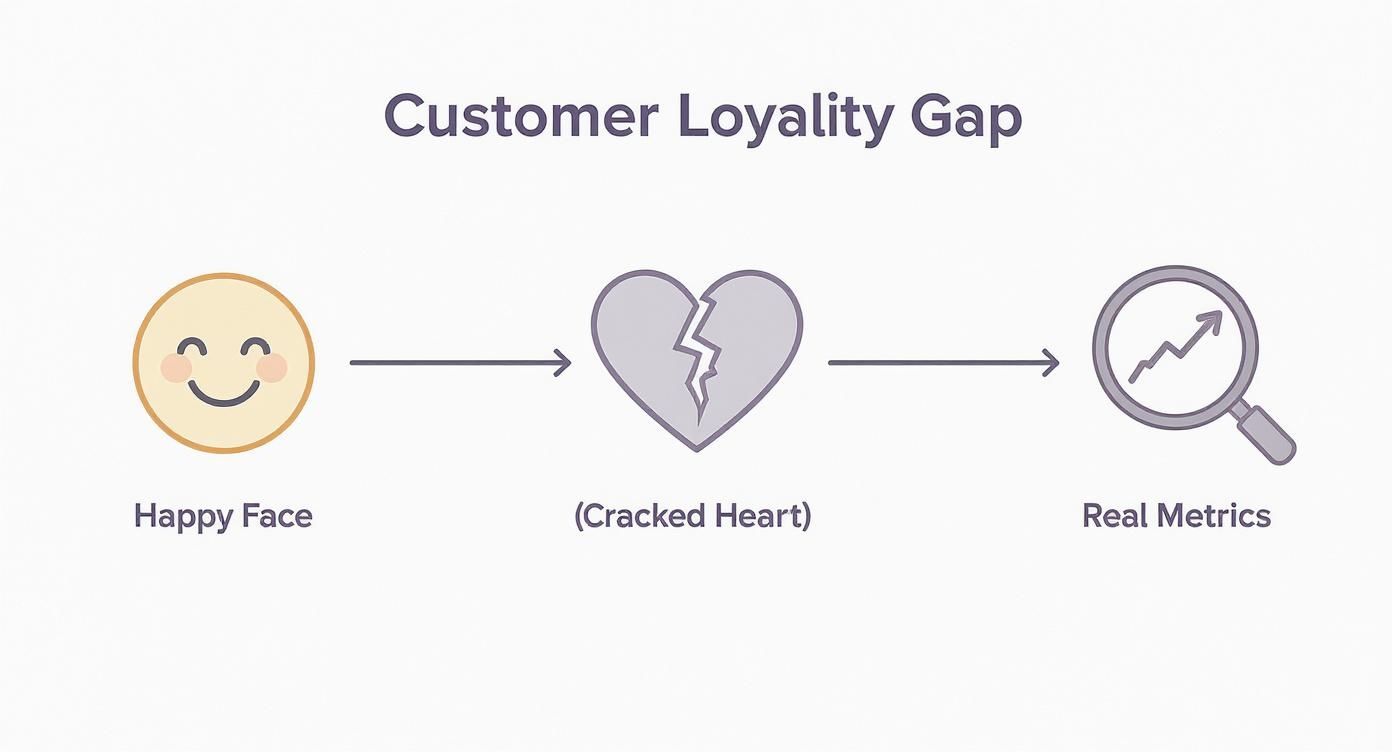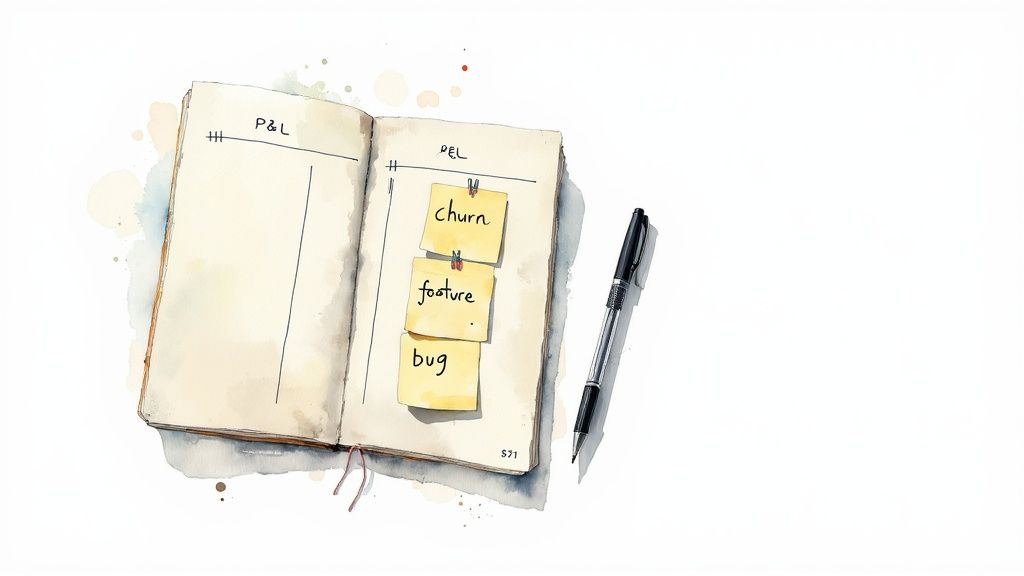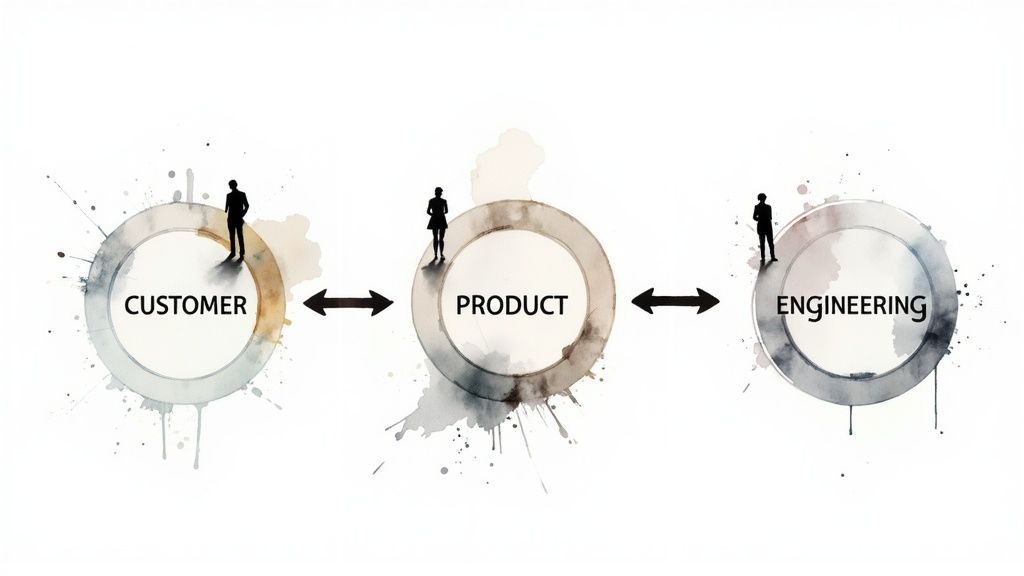Your Client Satisfaction Metrics Are a Lie
Stop guessing. This guide breaks down the client satisfaction metrics that actually predict revenue and prevent churn. No fluff, just founder-tested tactics.
Posted by
Related reading
A Founder's Guide to the New Products Development Process That Isn't Total BS
Tired of building products nobody wants? Learn the battle-tested new products development process that separates winning startups from the graveyard.
Your Customer Feedback Is Useless. Here's Why.
Discover the difference between a survey and questionnaire and learn how to collect actionable customer insights to grow your business.
Your Big Idea Is a Ticking Time Bomb. Here's How to Defuse It.
Stop wasting money on bad ideas. Learn to use concept test questions to get brutally honest feedback and validate your startup concept before you build.
Let’s be honest. You think you’re listening to your customers. You’ve got a dashboard with a pretty NPS score that you trot out in board meetings. You feel good about it. You’re also completely delusional.
That number is a vanity metric. A pacifier. It tells you nothing about the health of your business. The hard truth is most of your “satisfied” customers don’t give a damn about you. They’re one slightly better offer, one slicker onboarding, one competent competitor away from ghosting you forever. And they won’t even say goodbye.
I learned this the hard way. We were drowning in five-star ratings while our churn rate was quietly creeping up like a cancer. We were so busy collecting praise that we missed the fact that our silent majority was already halfway out the door. Ignore your customers, and you’ll be lucky to survive the quarter.
The most dangerous number in your business isn't a one-star review; it's the percentage of customers who feel just 'fine' but have zero real allegiance to your brand. They are one better offer away from churning, and you'll never even hear from them before they're gone.
When customers are unhappy, they often just leave. Understanding the warning signs and having a plan to get ahead of the problem is critical. For a deep dive, you can find proven strategies to reduce churn rate in this fantastic playbook.
The only thing that saved us was mastering the right client satisfaction metrics. The disconnect between simple satisfaction and genuine loyalty is a real threat. Recent studies have shown that while satisfaction rates look stable, actual customer loyalty—the kind measured by trust and repeat purchases—is falling off a cliff. Customers are content enough with a single transaction but feel no deep connection to the brands they buy from. You can explore this alarming trend in the full Qualtrics global research findings.
This isn't another HubSpot article. This is an intervention.
Takeaway: A satisfied customer will pay you today; a loyal customer will fund your future.
The Only Three Client Metrics That Actually Matter
Forget the MBA-speak and the alphabet soup of acronyms. Most client satisfaction metrics are noise designed to make consultants feel important. When you’re in the trenches, you only need three. Anything else is a distraction.
Think of them as your business’s vital signs: one checks the pulse after a specific event, another measures the friction in your system, and the last one predicts if the patient will live or die.
The Holy Trinity of Client Feedback
Don't spam your customers with a dozen different surveys. You get everything you need by looking at the client experience from three different angles: the past (a specific interaction), the present (the effort required), and the future (their loyalty).
- Customer Satisfaction (CSAT): This is your instant "how'd we do?" It’s a gut check on a single, specific event—like a support ticket closing or a project milestone. It answers the question: "Did we suck just now?"
- Customer Effort Score (CES): This metric cuts the crap. It measures friction. How much of a pain in the ass was it for your customer to get what they needed? In short: "Are we making your life easier or harder?"
- Net Promoter Score (NPS): This is your crystal ball. It’s not about one transaction; it's about the entire relationship. NPS gauges long-term loyalty and predicts if a customer will stick around and drag their friends along with them. It asks: "Are you one of us?"
This infographic nails a critical point: surface-level happiness can easily hide deeper issues with loyalty. You need to look beyond the smile.

A happy client today doesn't mean a loyal client tomorrow. You have to measure the strength of the relationship, not just the mood of the moment.
Why Focusing on Just One Metric Is a Huge Mistake
This is the classic rookie mistake. Picking one metric—usually NPS because it looks good in a pitch deck—and ignoring the rest. That’s like a pilot flying a plane while only looking at the altimeter. You’re climbing, great! Too bad the engine’s on fire.
A high CSAT score with a terrible CES score is a massive red flag. It means your support team are heroes, constantly saving people from your dumpster fire of a product or process. Customers love the person who rescued them but they’re exhausted from needing to be rescued.
Used together, these three metrics tell a story. They’re a system of checks and balances. One tells you if you delivered, the next tells you if it was a pain, and the last one tells you if the relationship is strong enough to survive your next screw-up. Want to dig deeper? Here's a great guide on how to measure customer loyalty and turn those insights into growth.
The Founder's Metrics Cheat Sheet
Don’t overthink it. Here’s a no-bullshit guide to which metric to use and when.
| Metric | What It Actually Measures | When to Use It | The Trap to Avoid |
|---|---|---|---|
| CSAT | The client's immediate mood. | Right after a support ticket closes, a purchase is made, or a project phase is completed. | Mistaking a good score for loyalty. They can love your support agent and still hate your product. |
| CES | How much pain you caused. | After any task is completed. Using your knowledge base. Completing a key workflow. | Ignoring the "why." A high-effort score is useless unless you find and fix the source of the friction. |
| NPS | If they're in your cult or not. | Quarterly or semi-annually. You’re tracking a relationship, not an interaction. | Obsessing over the number. The real gold is in the comments. The score is the headline; the comments are the story. |
This isn't about collecting data; it's about collecting intelligence.
Takeaway: Stop chasing a single score and start understanding the complete story your customers are telling you.
Your NPS Score Is a Vanity Metric Until You Do This
So, you hit a 72 NPS. Pop the champagne. It looks great on a slide. Now what? For most founders, the answer is... nothing. That score, on its own, is pure vanity. It’s the business equivalent of posting a gym selfie. Feels good, accomplishes nothing.
The number itself is worthless. The real work—the stuff that actually prevents churn and drives growth—is buried in the raw, unfiltered comments. The score tells you what. The comments tell you why. And the why is the only thing that protects your revenue.
From Scoreboard to Battle Plan
Stop treating customer feedback like a suggestion box and start treating it like intel from the front lines. The comments from each NPS segment are different types of signals. Learn to read them.
- Detractors (0-6): These aren't just unhappy users; they are active risks. Their comments are a roadmap to your biggest product gaps, your most infuriating processes, and the churn bombs waiting to go off. Fixing their problems isn't about saving one account; it's about plugging holes in the hull of your ship.
- Passives (7-8): This is the most dangerous group because their silence is so easily mistaken for contentment. They don't hate you, but they feel zero loyalty. Their feedback is a wishlist your competitor is probably already building. They are quietly telling you exactly what it would take for them to leave.
- Promoters (9-10): Don't just thank them. Weaponize their feedback. Their comments are pure marketing gold. Steal their exact language for your landing pages, ads, and sales pitches. They are literally handing you your value proposition.
An NPS survey without a mandatory comment field is a waste of everyone's time. You’re asking for a verdict without hearing the evidence. It’s a lazy approach that will teach you nothing of real value.
The process isn't rocket science. Read every damn comment. Tag them by theme—usability, pricing, support, feature requests. Count the tags. Rank them. Boom. You now have a data-backed priority list for your roadmap, not just a gut feeling from your last sales call.
Takeaway: Your NPS score is just the headline. The real story—the one that actually makes you money—is in the comments.
A Moneyball Approach to Customer Feedback
Stop treating customer feedback like a therapy session. It’s an economic indicator. Every comment, every support ticket, every survey response is a data point that should map directly to your P&L.
The biggest mistake founders make is listening to the loudest customer. The squeaky wheel gets the grease, right? Wrong. The squeaky wheel is probably a low-value customer complaining about a button color. Meanwhile, your biggest accounts are silently evaluating whether your platform can solve their next million-dollar problem.

This isn’t about making everyone happy. It’s about economic arbitrage—finding the insights with the highest leverage for growth.
Quantifying the Unquantifiable
You need a system to turn words into dollars. Start tagging every piece of feedback—NPS comments, support chats, sales call notes. Keep it simple. Three buckets:
- Churn Risk: Critical bugs, bad support, core workflow failures. These are fires.
- Expansion Opportunity: Requests for new features, integrations, or higher-tier plans. This is your future revenue.
- Product Defect: Minor bugs, UI annoyances. Paper cuts.
Now for the Moneyball part. Don't just count the tags; weigh them by revenue. A bug reported by ten small customers is a problem. That same bug reported by one enterprise customer blocking a $100,000 renewal is a crisis. You’ve just quantified the cost of inaction.
The goal isn’t to build a perfect product. It's to build the most profitable one. That means you fix the problems costing you the most money and build the features that will make you the most money. It’s really that simple.
This isn't theory. The data shows that customer-obsessed organizations experience 41% faster revenue growth and 49% faster profit growth. And for anyone worried about churn, improving satisfaction can slash it by up to 75%. To see a full breakdown of how client satisfaction metrics impact your bottom line, you can find more analysis on this data here.
Calculate the 'Cost of Ignoring'
Let’s make this real. Twenty customers request an integration. They’re all on your mid-tier plan, paying you $5,000/month total. They tell you this feature would make them upgrade to your pro plan, bringing their spend to $12,000/month.
- Potential ROI: $7,000/month in new MRR.
- Cost of Ignoring: A $5,000/month churn risk, because you know a competitor will build it eventually.
Now that feature request isn't a sticky note. It’s a business case. You can walk into a planning meeting and say, "This will cost two sprints, but it unlocks $84,000 in new ARR and protects $60,000 we already have." This is how you stop guessing and start executing based on financial impact.
Takeaway: Stop guessing what your customers want and start calculating what their requests are truly worth.
How to Build a Feedback Loop That Actually Works
Collecting data feels productive. It’s also a complete waste of time if it doesn't lead to action. Most feedback systems devolve into a chaotic mess of spreadsheets, forgotten Slack channels, and a product team that has learned to ignore you. It's a system for burnout, not results.
You don't need a project. You need a machine. A repeatable system that turns customer feedback into product improvements without driving everyone insane.

The single biggest failure is not "closing the loop." You ask for feedback, you build something, and then you never tell the customer who asked for it. This is a massive, unforced error. You are lighting loyalty on fire.
The Triage-Assign-Close Framework
Treat feedback like an ER. First, triage. Is this a gunshot wound (a bug bleeding revenue) or a scraped knee (a cosmetic suggestion)? Be ruthless.
Next, assign ownership. A feature request without a name on it is a wish. A bug report without an engineering lead is a future churn ticket. No ambiguity. Every actionable item gets a single owner.
Most feedback loops are broken because they’re one-way streets. Customers shout into a void and never hear anything back. The moment you personally email a customer and say, "Hey, we built that thing you asked for," you create a loyalist for life.
Finally, the step everyone skips: close the loop. This is your most powerful retention tool. When you ship an update, you must contact the customers who asked for it. It proves you listen and validates their effort. It’s the best marketing you will ever do. To get this right, it pays to review client communication best practices so your outreach feels helpful, not annoying.
Your Weekly Feedback Cadence
This is the exact, no-fluff meeting rhythm we used.
- Friday Review (30 Mins): Founder or product head scans all tagged feedback. Job: spot trends and triage the top 5-10 most impactful items.
- Monday Planning (60 Mins): The top items go straight into the product/eng planning meeting. Decisions are made, owners are assigned, work is scheduled.
- Ship & Notify: When a feature ships, the product manager pulls the list of requesters and sends a personal "we heard you" email.
This creates a rhythm, not a reaction. It forces discipline and makes customer feedback the heartbeat of your operation.
Takeaway: A feedback system that doesn't end with a personal "thank you" to the customer is a broken system.
Stop Analyzing and Start Shipping
Analysis paralysis is a disease. You’ve collected the metrics, read the feedback, built the dashboards. So what? The goal was never to build a museum of data. It was to make faster, smarter decisions. Stop admiring the problem and start shipping solutions.
All that intel is a tool. Use it. While your competitors are debating the statistical significance of a 0.5% CSAT dip in a conference room, you should be pushing code that fixes the exact problem your customers are yelling about.
Getting stuck in analysis mode is a luxury you can't afford. Your customers don't care about your process; they care about progress. Every week you spend debating is another week a competitor spends building.
Let's circle back. Feedback is a clue about future revenue. Quiet loyalty from your best customers is worth more than fleeting happiness from the masses. Your system must be built for action, not collection.
From Insights to Action
This isn't about moving fast and breaking things. It's about informed velocity. The data is a map pointing to the biggest fires. Your job is to grab the extinguisher, not write a report on the smoke.
Here’s a simple loop:
- Identify the top theme: What's the one thing that keeps coming up this week?
- Scope the smallest fix: What is the absolute fastest, simplest thing you can ship that addresses that theme?
- Ship and notify: Build it. Deploy it. Email the customers who brought it up.
This creates a flywheel. Action builds momentum. Momentum builds trust. Trust builds a business your competitors can’t touch. If you need help, our guide on choosing a feature prioritization framework can give you a simple model.
Takeaway: Stop debating and start doing. Your customers will reward you for the motion.
Frequently Asked Questions
Let's cut through the crap. Here are the real answers to the questions you have.
How Often Should I Measure These Metrics?
Don't overcomplicate it. NPS is a relationship check-up, so do it quarterly. You're looking for long-term trends, not daily mood swings. CSAT and CES are transactional. Trigger them immediately after a key moment—a support ticket closes, onboarding finishes. Ask while the memory is fresh.
What Is a Good Score for NPS, CSAT, or CES?
This is a trap. Benchmarks are mostly useless. Comparing your score to some other company is a vanity exercise. The only benchmark that matters is your own.
A "good" score is any score that is better than the one you had last month or last quarter. Your goal isn't to beat a competitor's score; it's to continuously improve your own customer experience. Focus on your own trendline—that’s where the real story is.
How Do I Implement This with a Small Team?
You don't need a data science team. You need discipline. Get a tool to automate the collection. Let the software handle the numbers. Then, block 2 hours a week for a human—you—to read the comments. Your job is to find the why behind the numbers and decide what's next.
What If Customers Don't Respond to My Surveys?
Low response is feedback. It means they either don't care about you or they don't believe you'll do anything with their input. The fix is simple:
- Make it effortless: Use one-click, in-app surveys. No one has time for a 10-question monstrosity.
- Prove you're listening: When you ship something based on feedback, email the people who asked for it. When they see their voice leads to action, they'll start talking.
Stop letting your best insights die in a spreadsheet and go turn customer feedback into an unfair advantage with Backsy. See how to translate raw comments into a clear action plan in under five minutes.